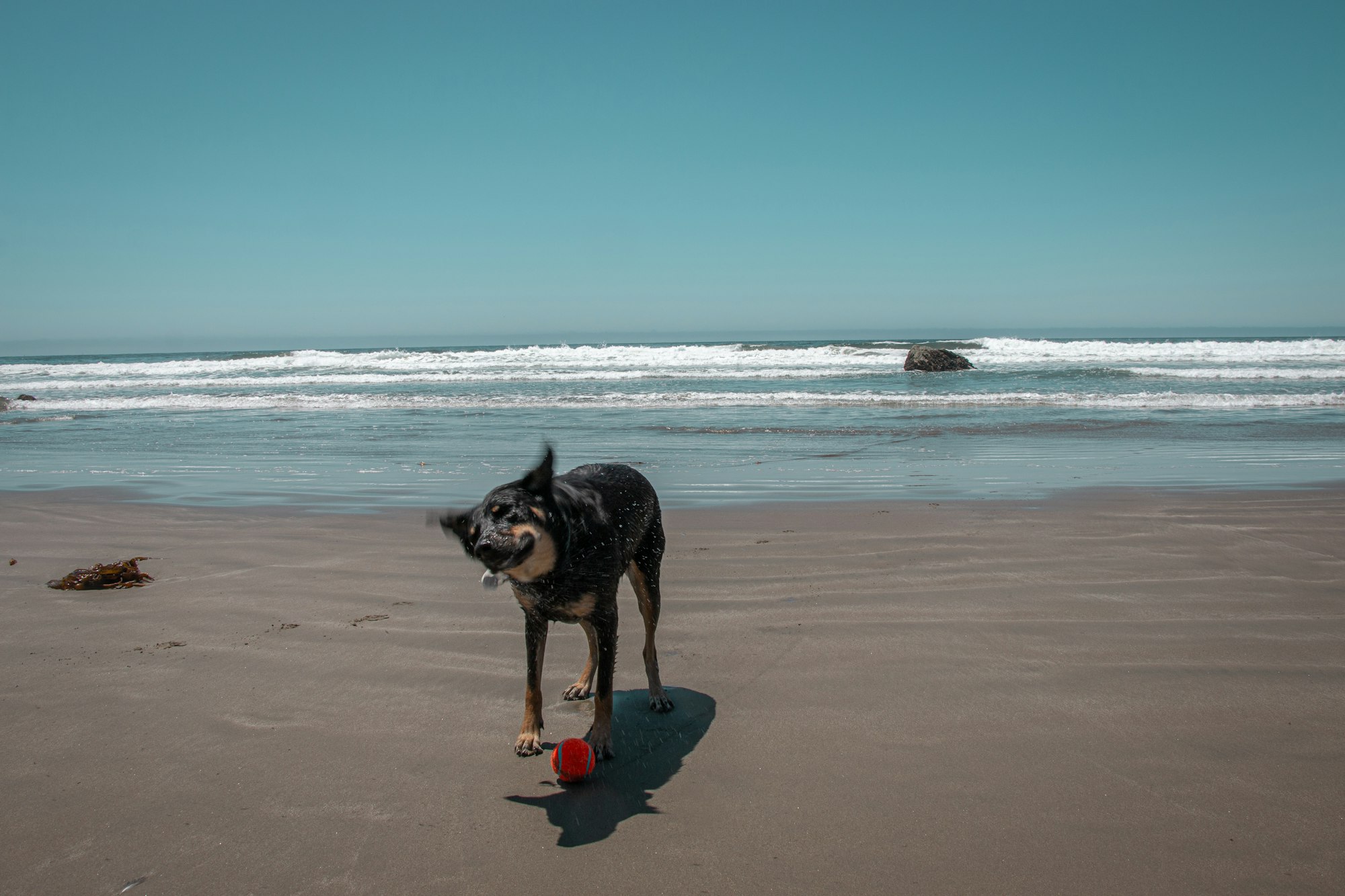Have you ever found yourself wondering, "Why is my dog shaking?" It's a common concern for pet owners, and understanding the various reasons behind this behavior is crucial for your furry friend's well-being. In this article, we'll delve into the perplexing world of canine shivering, exploring everything from normal behavior to potential health issues. So, let's shake off the confusion and uncover the reasons behind your dog's shakes.

We all love seeing our dogs wag their tails and playfully shake off water after a bath. However, when shaking becomes more frequent or seems excessive, it's natural to question why. In this article, we'll break down the potential causes behind your dog's shaking, offering insights and practical tips for a happy and healthy canine companion.
Normal Behavior vs. Concerning Signs
Dogs are expressive creatures, and their behavior often communicates various emotions. Understanding the line between normal behavior and concerning signs is crucial for every dog owner. Let's explore the nuances to decipher why your dog might be shaking.
Normal Behavior
1. After Bathing:
- Normal Behavior: It's typical for dogs to shake vigorously after a bath. This is their instinctive way of getting rid of excess water and drying off.
2. Playful Behavior:
- Normal Behavior: Dogs may shake as part of their playfulness, especially during activities like fetch or when excited.
3. Stretching:
- Normal Behavior: Stretching can induce a mild shake in dogs, similar to humans shaking off stiffness.

Concerning Signs
1. Excessive Shaking:
- Concerning Sign: If your dog is shaking persistently without an apparent reason, it might indicate an underlying issue.
2. Trembling:
- Concerning Sign: Continuous trembling, especially when at rest, can signal pain, anxiety, or a health problem.
3. Uncontrolled Shaking:
- Concerning Sign: If your dog exhibits uncontrolled shaking, as if they can't stop, it may be a cause for concern and should be evaluated by a vet.
Environmental Factors
Environmental factors play a significant role in a dog's well-being, and they can often be a cause for shaking. Understanding and managing these factors can contribute to a happier and healthier furry friend.
Temperature and Weather:
- Dogs may shake when they are too cold. Ensure your dog has a warm and comfortable environment, especially in colder weather.
Anxiety-Inducing Situations:
- Dogs, like humans, can experience anxiety. Changes in the environment, new people, or loud noises may induce shaking.
Excitement:
- Excessive excitement, such as anticipating a walk or seeing a favorite toy, can lead to shaking. This is generally normal but should be proportionate to the situation.
Managing Environmental Influences:
- Provide a cozy and safe space for your dog, especially during thunderstorms or fireworks.
- Gradually expose your dog to anxiety-inducing situations to help them acclimate.
- Maintain a consistent routine to reduce environmental stressors.
Health Issues
Ensuring your dog's health is paramount, and sometimes, shaking can be an indication of an underlying issue. Let's delve into potential health-related causes for why your dog might be shaking.
Anxiety and Stress:
- Common Cause: Dogs, much like humans, can experience anxiety and stress, leading to shaking. Changes in routine, loud noises, or separation anxiety are common triggers.
Pain or Discomfort:
- Common Cause: Dogs may shake as a response to pain or discomfort. It could be due to an injury, arthritis, dental issues, or any condition causing physical distress.
Illness:
- Common Cause: Various illnesses, including infections or organ-related issues, can manifest through shaking. If shaking is accompanied by other signs like lethargy or changes in appetite, consult a veterinarian.
Addressing Health-Related Shaking:
- Regular veterinary check-ups are crucial to catch and address potential health issues early.
- Observing changes in behavior, appetite, or energy levels can provide valuable insights into your dog's health.
Breed-specific Characteristics
Different dog breeds exhibit unique traits, and some are predisposed to shaking more than others. Understanding breed-specific characteristics helps differentiate between normal behavior and potential concerns.

Small Breeds:
- Common Trait: Small breeds, such as Chihuahuas or Toy Poodles, may shake due to their higher metabolism and sensitivity to environmental changes.
Short-Haired Breeds:
- Common Trait: Dogs with short hair may shake more frequently, especially in colder temperatures, as they are more susceptible to the cold.
Energetic Breeds:
- Common Trait: Energetic breeds, like Border Collies or Australian Shepherds, may shake as a way to release excess energy. Ensuring regular exercise can help manage this.
Addressing Breed-specific Shaking:
- Research your dog's breed to understand their typical behaviors and tendencies.
- Provide appropriate care based on your dog's breed characteristics, such as adjusting exercise routines or ensuring warmth for short-haired breeds.
Behavioral Causes
Dogs are complex beings with emotions and behaviors influenced by various factors. Behavioral causes can contribute significantly to shaking, and understanding them is key to addressing the root of the issue.
Fear and Anxiety:
- Common Cause: Dogs may shake due to fear or anxiety, triggered by situations like thunderstorms, fireworks, or unfamiliar environments.
Excitement:
- Common Cause: Excessive excitement, such as before mealtime or a walk, can lead to shaking. This is generally harmless but should be proportional to the situation.
Separation Anxiety:
- Common Cause: Dogs may shake when experiencing separation anxiety. This can occur when they are left alone for extended periods.
Addressing Behavioral Causes:
- Create a safe and secure environment to help alleviate fear and anxiety.
- Gradual exposure to anxiety-inducing situations can desensitize your dog over time.
- Positive reinforcement and reward-based training can help manage and modify undesired behaviors.
Behavioral Causes
Dogs are emotional creatures, and behavioral factors can contribute to shaking. Whether it's fear, stress, or excitement, understanding the root cause allows you to implement effective strategies for a more relaxed pup.
Managing Behavioral Shaking
We'll provide practical tips on managing behavioral shaking, including creating a safe space, positive reinforcement, and calming techniques. Your dog's mental well-being is just as important as their physical health.
Diet and Nutrition
A dog's diet plays a significant role in their overall health, and nutritional imbalances can sometimes contribute to shaking. Let's explore how diet and nutrition can impact your dog's well-being.
Balanced Diet:
- Essential Factor: Providing a balanced diet with the right proportions of proteins, fats, carbohydrates, vitamins, and minerals is crucial. Nutrient deficiencies can lead to various health issues, including shaking.
Food Allergies:
- Common Cause: Some dogs may develop allergies to certain ingredients in their food, leading to discomfort and shaking. Identifying and eliminating allergens is essential for their well-being.
Hydration:
- Essential Factor: Proper hydration is vital for your dog's health. Dehydration can cause weakness and shivering. Always ensure access to fresh and clean water.
Addressing Dietary Factors:
- Consult with your veterinarian to determine the most suitable diet for your dog's age, breed, and health condition.
- Gradually introduce new foods and monitor your dog for any adverse reactions.
- Regularly check for signs of food allergies, such as itching, digestive issues, or shaking.
The Role of Exercise
Exercise is not just about keeping your dog physically fit; it also contributes significantly to their mental well-being. Understanding the role of exercise is crucial for preventing unnecessary shaking.
Physical Exercise:
- Essential for Health: Regular physical activity helps maintain a healthy weight, prevents muscle stiffness, and reduces excess energy that may otherwise manifest as shaking.
Mental Stimulation:
- Crucial for Well-being: Mental stimulation through activities like puzzle toys, interactive games, or training sessions is as important as physical exercise. It prevents boredom-related anxiety and shaking.
Routine and Consistency:
- Key to Success: Establishing a consistent exercise routine is beneficial for dogs. Sudden changes or long periods of inactivity can lead to restlessness and shaking.
Addressing Exercise-related Factors:
- Tailor exercise routines based on your dog's breed, age, and energy levels.
- Combine both physical and mental exercises to ensure a well-rounded approach.
- Be consistent with daily walks, playtime, and engaging activities to keep your dog active and content.
Grooming and Hygiene
Proper grooming and hygiene practices contribute not only to your dog's physical comfort but also to their mental well-being. Let's explore how grooming can play a role in preventing shaking.
Comfortable Coat:
- Essential for Well-being: Regular brushing ensures a clean and comfortable coat. Dogs with mats or tangled fur may feel discomfort, leading to shaking.
Nail Trimming:
- Essential for Health: Overgrown nails can be painful for dogs and affect their gait. Regular nail trimming prevents discomfort and contributes to overall well-being.
Ear and Dental Care:
- Crucial for Health: Regular cleaning of ears and teeth is essential. Infections or dental issues can cause pain, leading to shaking and other signs of distress.
Addressing Grooming-related Factors:
- Establish a grooming routine that includes brushing, nail trimming, and other necessary care.
- Use appropriate grooming tools and techniques to ensure your dog's comfort.
- Monitor for signs of discomfort during grooming and consult a professional groomer if needed.
Signs Requiring Immediate Veterinary Attention
Not all shaking is harmless. We'll highlight signs that indicate your dog needs urgent veterinary attention. Prompt action is crucial for addressing serious health issues and ensuring your pet receives the care they need.

Red Flags for Urgent Veterinary Care
Recognizing the signs of severe or persistent shaking is vital. We'll discuss symptoms that warrant an immediate trip to the veterinarian and why ignoring them could be detrimental to your dog's health.
Home Remedies and Comfort Measures
For mild shaking episodes, there are safe and effective home remedies you can try. We'll explore these remedies and discuss the importance of creating a comfortable and stress-free environment for your furry friend.
Creating a Comfortable Environment
Discover how simple changes to your home environment can positively impact your dog's behavior. From cozy beds to soothing music, we'll explore various ways to create a stress-free haven for your pet.
Consulting a Veterinarian
When in doubt, consult a professional. We'll emphasize the importance of seeking veterinary advice for a thorough examination of your dog's health. A veterinarian can provide tailored recommendations based on your dog's specific needs.
The Veterinarian's Role in Addressing Shaking
Explore the role of veterinarians in diagnosing and treating shaking in dogs. From comprehensive examinations to personalized treatment plans, professional guidance is invaluable in ensuring your dog's well-being.
Training Techniques
Effective training plays a crucial role in managing and preventing shaking behavior in dogs. Let's explore positive training techniques that can help address anxiety and stress, promoting a more relaxed and happy canine companion.
Positive Reinforcement:
- Key Approach: Positive reinforcement involves rewarding desired behaviors, and reinforcing a positive association. Treats, praise, or play can be powerful motivators for your dog.
Desensitization:
- Gradual Exposure: Desensitization involves exposing your dog gradually to anxiety-inducing situations. This helps them become accustomed to triggers, reducing the likelihood of shaking.
Calming Techniques:
- Soothing Methods: Techniques such as massage, gentle petting, or playing calming music can help soothe an anxious dog and reduce shaking.
Consistency and Patience:
- Essential Elements: Consistency in training methods and patience are crucial. Dogs respond well to routines, and positive changes may take time.
Professional Training:
- Seeking Guidance: If shaking persists despite your efforts, consider seeking professional help from a certified dog trainer or behaviorist.

Conclusion
In conclusion, understanding why your dog is shaking is the first step toward ensuring their well-being. By addressing environmental factors, health issues, and behavioral causes, you can create a happier and healthier life for your furry friend.
FAQs: Unraveling the Mystery of Dog Shaking
- Q: Is it normal for dogs to shake after a bath?
- A: Yes, many dogs shake to dry off after a bath. It's a normal behavior associated with the joy of being clean.
- Q: When should I be concerned about my dog's shaking?
- A: If shaking is persistent, uncontrollable, or accompanied by other concerning signs, it's advisable to consult with a veterinarian.
- Q: Can certain breeds shake more than others?
- A: Yes, some breeds are more prone to shaking due to their unique characteristics. However, excessive shaking should still be investigated.
- Q: How can I help my dog with anxiety-related shaking?
- A: Creating a safe space, using positive reinforcement, and considering calming techniques can be beneficial for dogs experiencing anxiety-related shaking.
- Q: What should I do if my dog's shaking is sudden and severe?
- A: Seek immediate veterinary attention. Sudden and severe shaking can be indicative of a serious health issue that requires prompt intervention.






